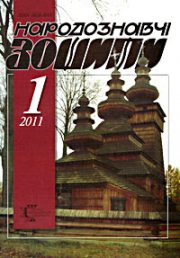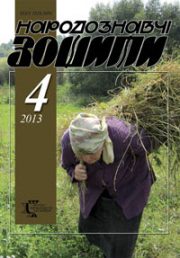The Ethnology Notebooks. 2024. № 5 (179), 1137—1149
UDK 398.341(100)
DOI https://doi.org/10.15407/nz2024.05.1137
THE ROOF OF THE BUILDING IN THE RITE OF THE DEVOTION
RAKHNO Kostyantyn
- ORCID ID: https://orcid.org/0000-0002-0973-3919
- Doctor of History, Associate Professor, Leading Researcher
- of the National Museum of Ukrainian Pottery in Opishne,
- 102, Partyzanska Street, 38164, Opishne, Zinkiv District,
- Poltava Region, Ukraine,
- Contacts: e-mail: krakhno@ukr.net
Abstract. Belief in evil eye is one of the most common manifestations of magical thinking. The very names of the evil eye are very similar among different peoples, as well as the ways to eliminate it. An important place in the rites of removal of the evil eye was occupied by the roof as a sacred part of the house, which protected its inhabitants and at the same time served as a place of contact with supernatural forces.
The purpose of the article is to investigate the rites of removing the evil eye, in which the roof of the house appeared, and their connections with the ideas about the sacredness of the roof among different peoples of the world.
The object of the research is ethnographically recorded examples of superstitious omens related to the evil eye, magical protection against it and methods of its elimination. According to the popular ideas, the evil eye consisted in the harmful influence of some people’s view on someone or something. Ethnographers have recorded many manifestations of ritual behavior related to the roof of the house and aimed at protecting and guarding oneself and loved ones from bereavement. Various apotropaic images and objects placed on the roof to be visible to evil eyes served as preventive amulets against lessons. Amulets were placed under the roof. During the treatment of lessons in folk medicine, dishes and other things used in the ritual were placed on the roof. Objects were thrown over the roof, on which the evel eye was transferred. An important symbolic role was also played by the ridge of the roof, the eaves of the roof, the attic, and the chimney.
The methodological basis of the research is the comparative-historical methodological toolkit.
The basis of the work are ethnographic materials related to the perception of the roof in traditional culture. The results of the research show that the peoples of the world, including the Ukrainians and their neighbours, had many options for protection against hostile or unkind views. Among them were both preventive rites and customs that were supposed to avert the threat, as well as those aimed at treating the consequences of evil eye and its elimination. Many of them were carried out on such a semiotically important structural part of a traditional house as the roof.
Keywords: customs, beliefs, rituals, folk medicine, roof, mythology, traditional culture.
Received 4.10.2024
REFERENCES
- Kagarov, Ye. (1913). The Cult of Fetishes, Plants and Animals in Ancient Greece. St. Petersburg: Senate Printing House [in Russian].
- Gasparov, M.L. (Ed.). Quintus Horatius Flaccus (1970). Odes. Epods. Satires. Epistles. Moscow: Imaginative Literature [in Russian].
- Rubin, S. (1888). History of Superstition. Leipzig: Publishers of E. Thiele [in German].
- Bachter, S. (2012). Magic, Superstition, Popular Piety. Documenta historiae, 14, 1—54 [in German].
- Engemann, J. (1975). On the Spread of Magical Defense Against Evil in Non-Christian and Christian Late Antiquity. Yearbook for Antiquity and Christianity, 18, 22—48 [in German].
- Jahn, O. (1855). On the Superstition of the Evil Eye among the Ancients. Reports on the Proceedings of the Royal Saxon Society of Science in Leipzig. Philological-Historical Class, 7, 28—111 [in German].
- Busch, M. (1877). German Popular Belief. Leipzig: Publishers of Fr. Wilh. Grunow [in German].
- Seligmann, S. (1910). The Evil Eye and Related Things: a Contribution to the History of Superstition of All Times and Peoples (Vol. 1). Berlin: Hermann Barsdorf Verlag [in German].
- Thumen, F. v. (1881). The Plant as a Magic Remedy. Writings of the Association for the Dissemination of Scientific Knowledge in Vienna, Association year 1880/81, 325—360 [in German].
- Strackerjan, L. (1867). Superstition and Legends from the Duchy of Oldenburg (Vol. 2). Oldenburg: Printed and published by Gerhard Stalling [in German].
- Hahnzog, Ch.L. (1784). Sermons against the Superstition of the Country People. Magdeburg: Verlag der Scheidhauerischen Buchhandlung[in German].
- Toppen, M. (1867). Superstition from Masuria. Danzig: Publisher Th. Bertling [in German].
- Samter, E. (1911). Birth, Marriage and Death. Leipzig and Berlin: Printed and published by B.G. Teubner [in German].
- Rakhimov, M.R. (1957). Agriculture of the Tajiks of the Obihingou River Basin in the Pre-Revolutionary Period (Historical and Ethnographic Essay). Stalinabad: Publishing House of the Academy of Sciences of the Tajik SSR [in Russian].
- Kolberg, O. (1968). Complete Works (Vol. 52. Belarus-Polesie). Wroclaw, Cracow and Warsaw: Polish music publishing house; People’s Publishing Cooperative[in Polish].
- Tyszkiewicz, E. (1847). Description of the Borysуw District in Terms of Statistics, Geognostics, History, Economy, Industry, Commerce and Medicine, etc. Vilnius: Ant. Marcinowski printing house[in Polish].
- Seligmann, S. (1910). The Evil Eye and Related Things: a Contribution to the History of Superstition of All Times and Peoples (Vol. 2). Berlin: Hermann Barsdorf Verlag [in German].
- Filipovic, M.S. (1951). Women’s Ceramics among the Balkan Peoples. Belgrade: Serbian Academy of Sciences, Ethnographic Institute [in Serbian].
- Chausidis, N., & Nikolov, G. (2006). Tsrepna and Vrshnik: Mythological-semiotic analysis. Studia mythologica slavica (Vol.IX, pp. 97—160) [in Macedonian].
- Kohlbrugge, J.H.F. (1926). Animal and Human Faces as Defensive Magic. Bonn: Kurt Schroeder Verlag[in German].
- Yuguang, Fu. (2021). Shamanic and Mythic Cultures of Ethnic Peoples in Northern China I: Shamanic Deities and Rituals. London and New York: Routledge.
- Frazer, J.G. (1911). The Golden Bough: A Study in Magic and Religion (Part III: The Dying God). London: MacMillan and Co., Limited.
- Zelenin, D.K. (1991). East Slavic Ethnography. Moscow: Nauka [in Russian].
- Karaketov, M.D. (1995). From the Traditional Ritual and Cult Life of the Karachays. Moscow: Nauka [in Russian].
- Radin, P. (1956). The Trickster: A Study in American Indian Mythology. New York: Philosophical Library.
- Varchol, J., & Varchol, N. (1999). Customs and Superstitions in Folk Architecture and Housing of the Ruthenians-Ukrainians in Slovakia. Traditions of Construction and Living in Slovakia with a Special Emphasis on Cultural Expressions in the Environment of Ethnic Minorities. Collection of Papers from the Scientific Conference with International Participation Held as Part of the Days of European Cultural Heritage in Slovakia, Svнdnik, 9—10 September 1999 (Pp. 122—131). Presov: EXCO s.r.o. [in Slovak].
- Rybakov, B.A. (2002). Paganism of the Ancient Slavs. Moscow: Sofia; Helios [in Russian].
- Wijaczka, J. (2008). Magic and Spells: The Hunt for Witches and Sorcerers in Ducal Prussia in Early Modern Times. Torun: Adam Marszalek Publishing House [in Polish].
- Fisun, V. (1998). Verbal Magic of the Ukrainians. Kyiv: Library of the Ukrainian [in Ukrainian].
- Elworthy, Fr.Th. (1895). The Evil Eye: An Account of This Ancient & Widespread Superstition. London: John Murray.
- Frischbier, H. (1870). Witch Sayings and Magic Spells: A Contribution to the History of Superstition in the Province of Prussia. Berlin: Publisher of T. C. F. Enslin (A. Enslin) [in German].
- Krauss, Fr.S. (1890). Folk Belief and Religious Customs of the South Slavs. Munster: Printed and published by the Aschendorff Bookshop[in German].
- Lilek, E. (1896). Folk Belief and Popular Cult in Bosnia and Herzegovina. Vienna: Printed and published by Adolf Holzhausen[in German].
- Svorc, P. (1979). Strba. Kosice: Eastern Slovakian Publishing House[in Slovak].
- Marec, J. (2011). Traditional Healing and Folk Magic in Upper Kysuce. Martin: Slovak Matica Publishing House[in Slovak].
- Jakubikova, K. (1972). Spiritual Culture of the People. Zamagurie. Ethnographic Monograph of the Region (Pp. 195—272). Poprad and Kosice: Department of Culture ONV and House of Culture and Education in Eastern Slovakian Publishing House [in Slovak].
- (1995). Encyclopedia of Slovak Folk Culture (Vol. 2). Bratislava: Science [in Slovak].
- Biegeleisen, H. (1929). Medicine of the Polish People. Cracow: Polish Academy of Arts [in Polish].
- Gluck, L. (1894). Sketches of Folk Medicine and Medical Superstition in Bosnia and Herzegovina. Scientific reports from Bosnia and Herzegovina (Vol. 2, pp. 392—454). Vienna: in commission with Carl Gerold’s son [in German].
- Begovic, N. (1887). Life and Customs of Serb Border Guards. Zagreb: Printing Office «National Newspaper» [in Serbian].
- Zelenin, D.K. (1914). Description of the Manuscripts of the Scientific Archive of the Imperial Russian Geographical Society (Issue 1). Petersburg: A.V. Orlov Printing House [in Russian].
- Agapkina, T.A. (2002). Mythopoetic Foundations of the Slavic Folk Calendar. Spring-Summer Cycle. Moscow: Indrik [in Russian].
- Garnizov, V. (1986). Objects and Space in the Funeral and Memorial Rites from Mihaylovgrad Region. Bulgarian Folklore, 3, 16—29 [in Bulgarian].
- (1925). Transylvanian-Saxon Dictionary (Vol. 2: D—F). Berlin and Leipzig: Walter de Gruyter & Co [in German].
- Mijatovic, St.M. (1909). Folk Medicine of Serbian Peasants in Levac and Temnic. Serbian Ethnographic Collection (Book XII, pp. 258—482) [in Serbian].
- Rees, A., & Rees, B. (1999). Celtic Heritage: Ancient Tradition in Ireland and Wales. Moscow: Enigma [in Russian].
- Wirleitner, Fr. (1931). Sympathetic Means of popular cattle doctoring in the Austrian Alpine Countries. Vienna Journal of Folklore, 36, 16—34 [in German].
- Scheftelowitz, I. (1912). The Snare and Net Motif in the Beliefs and Customs of the Peoples. GieЯen: Alfred Tцpelmann Publishers [in German].
- Seligmann, S. (1921). The Magic Power of the Eye and Calling: a Chapter from the History of Superstition. The Hague: J. Couvrer Publishers[in German].
- Khristolyubova, L.S. (1984). Family Rituals of the Udmurts: Traditions and Processes of Renewal. Izhevsk: Udmurtia[in Russian].
- Donaldson, B.A. (1938). The Wild Rue. A Study of Muhammadan Magic and Folklore in Iran. London: Luzac and Co.
- McDaniel, J. (2014). The Material Turn: An Introduction to Thai Sources for the Study of Buddhist Amulets. Material Culture and Asian Religions: Text, Image, Object (Pp. 135—148). New York and Abingdon: Routledge.
- McDaniel J.Th. (2013). The Lovelorn Ghost and the Magical Monk: Practicing Buddhism in Modern Thailand. New York and Chichester: Columbia University Press.
- Westermarck, E. (1926). Ritual and Belief in Morocco: in two volumes (Vol. II). London: MacMillan and Co., Limited.
- Bulatov, B.B., Gashimov, M.F., & Seferbekov, R.I. (2004). Culture and Life of the Tabasarans in the 19th—20th Centuries. Makhachkala: Institute of History, Archeology and Ethnography of the Dagestan Scientific Center of the Russian Academy of Sciences [in Russian].
- Georgiev, M. (Ed.). (1999). Illness. Bulgarian Folk Medicine: an Encyclopedia (Pp. 217—219). Sofia: «Peter Beron» Publishing House[in Bulgarian].
- Horvathova, E. (1974). Spiritual Culture. Upper Hron Region: Culture and Way of Life of the People (Pp. 245—371). Bratislava: Science, publishing house of the Slovakian Academy of Sciences [in Slovak].
- Kosir, P., & Moderndorfer, V. (1926). Folk Medicine among the Carinthian Slovenians. Maribor: published by the «Historical Society»; rinted by Maribor printing house [in Slovenian].
- Moderndorfer, V. (1964). Folk Medicine among the Slovenians. Ljubljana: Slovenian Academy of Sciences and Arts [in Slovenian].
- Liebrecht, F. (1879). On Ethnology: Old and New Essays. Heilbronn: Publishing house of the Henninger Bros[in German].
- Weiser, L. (1925). The Farmhouse in Popular Belief. Reports of the Anthropological Society in Vienna (Vol. LVI, pp. 1—15)[in German].
- Leoprechting, K. (1855). From the Lechrain: On German Customs and Legends. Munich: Literary-Artistic Institute[in German].
- Marr, Yu.N. (1927). An Autobiography of Mirza Mohammed Qermani and His Work on the Beliefs and Customs Associated with the «Red Wednesday». II. Translation and Commentary. Bulletin of the USSR Academy of Sciences (Series VI, vol. 21, issue 5, p. 825—838) [in Russian].
- Hedayat, S. (1958). Neirangistan. Western Asian Ethnographic Collection (Vol. I, pp. 259—336). Moscow: Publishing House of the Academy of Sciences of the USSR [in Russian].
- Logashova, B.-R. (1998). Persians. Calendar Customs and Rituals of the Peoples of Near East. Annual Cycle (Pp. 39—111). Moscow: Nauka [in Russian].
- John, A. (1905). Contributions to German-Bohemian Folklore: Customs, Traditions, and Folk Beliefs in German West Bohemia. Prague: J.G. Calve Imperial and Royal Court and University Bookshop [in German].







